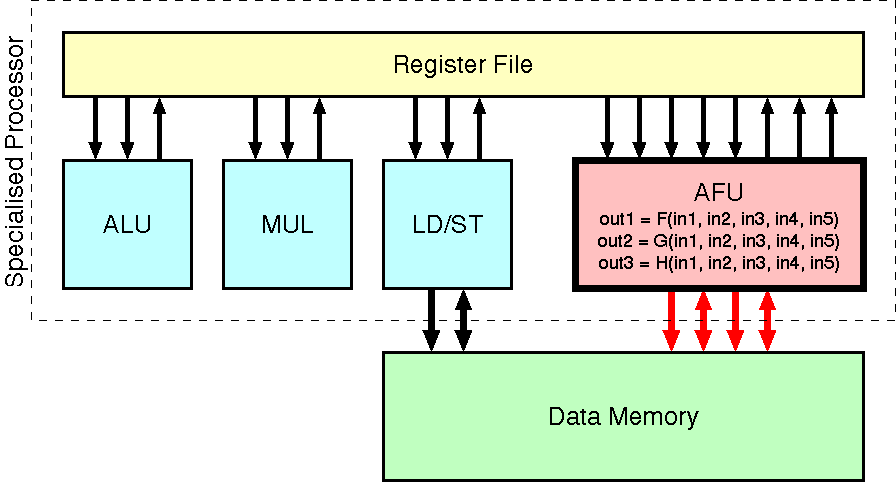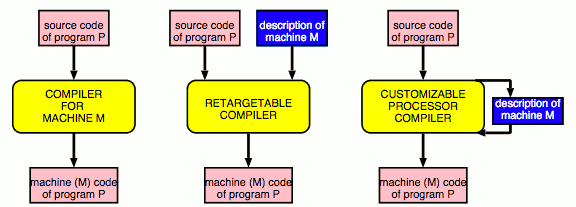Compilers for
Customisable Processors
The embedded computing
word is characterised by a blend of stringent
constraints such as high performance, low power, and fast time to
market. In such scenario, Customisable Processors represent a very
attracting solution, as they typically allow designers to extend
relatively simple processors with application-specific features. Many
of such processors have emerged in the market, e.g., Tensilica
Xtensa, ARC ARCtangent,
STMicroelectronics ST200, and Xilinx
Virtex-4, all allowing some degree of
extensibility. In particular, they provide the designer with the
possibility of adding Instruction
Set Extensions (ISEs) to
a basic Instruction Set, so that
critical parts of an embedded
application can be run in hardware, in Application-specific Functional
Units (AFUs). The figure below depicts a simplified view of a
customisable processor extended
with an AFU, aimed at executing a
critical part of an application directly in hardware.

Typical extensible processor with a five-input three-output application-specific functional unit.
Of course, an important design decision lays in which part of the application code is best assigned to ISEs. Most customisable processors in the market still leave to the designer the task of choosing the most efficient ISEs for a given application---while
providing development environments with simulation capabilities for evaluating the efficiency of hand-crafted ISEs. On the other hand, research teams have proposed in the last decade a number of methods for identifying such ISEs automatically, from application source code---see our page on automatic instruction set extension---and these methods are slowly but surely finding their place in commercial solutions. Design Automation is therefore raising to the point that application-specific ISEs can be identified by a software module, analysing the application source code. Naturally, this software module can be seen as part of a (very particular) compiler.
Effectively, what we are witnessing is an automation trend that gives the compiler more and more capabilities, and this in turn leads to the observation that the compiler role is changing. Observe the next figure: Initially, the compiler simply translated a high-level source code into machine code for a given machine, as in part (a) of the figure. Part (b) shows the role of retargetable compilers that later emerged, and that are able to translate source code into machine code for a set of machines, by reading a machine description as input. However, we can now go one step further and introduce a compiler---shown in part (c)---that is itself allowed to complete the machine description, i.e. to define application-specific extensions to a basic Instruction Set, and then compile onto it.

a) A compiler for a specific machine. b) A retargetable compiler reads in a machine description and generates code for it. c) A compiler for a customisable processor can generate the description of the best machine for a given application, and then produce code for it.
The inspiration for this research comes precisely from the realisation of this new compiler role, and, in particular, a question begs to be answered: are traditional compiler techniques, aimed at standard RISC microprocessor execution, suitable for this new compilation process, i.e., compilation including the definition of Instruction Set Extensions? Or do traditional techniques need to be redesigned, or at least re-tuned, in order to be beneficial in this new scenario? We argue that there is indeed a need to revisit many traditional compiler decisions. See:

Typical extensible processor with a five-input three-output application-specific functional unit.
Of course, an important design decision lays in which part of the application code is best assigned to ISEs. Most customisable processors in the market still leave to the designer the task of choosing the most efficient ISEs for a given application---while
providing development environments with simulation capabilities for evaluating the efficiency of hand-crafted ISEs. On the other hand, research teams have proposed in the last decade a number of methods for identifying such ISEs automatically, from application source code---see our page on automatic instruction set extension---and these methods are slowly but surely finding their place in commercial solutions. Design Automation is therefore raising to the point that application-specific ISEs can be identified by a software module, analysing the application source code. Naturally, this software module can be seen as part of a (very particular) compiler.
Effectively, what we are witnessing is an automation trend that gives the compiler more and more capabilities, and this in turn leads to the observation that the compiler role is changing. Observe the next figure: Initially, the compiler simply translated a high-level source code into machine code for a given machine, as in part (a) of the figure. Part (b) shows the role of retargetable compilers that later emerged, and that are able to translate source code into machine code for a set of machines, by reading a machine description as input. However, we can now go one step further and introduce a compiler---shown in part (c)---that is itself allowed to complete the machine description, i.e. to define application-specific extensions to a basic Instruction Set, and then compile onto it.

a) A compiler for a specific machine. b) A retargetable compiler reads in a machine description and generates code for it. c) A compiler for a customisable processor can generate the description of the best machine for a given application, and then produce code for it.
The inspiration for this research comes precisely from the realisation of this new compiler role, and, in particular, a question begs to be answered: are traditional compiler techniques, aimed at standard RISC microprocessor execution, suitable for this new compilation process, i.e., compilation including the definition of Instruction Set Extensions? Or do traditional techniques need to be redesigned, or at least re-tuned, in order to be beneficial in this new scenario? We argue that there is indeed a need to revisit many traditional compiler decisions. See:
Paolo Bonzini and Laura
Pozzi. Code Transformation
Strategies for Extensible Embedded Processor. In Proceedings of IEEE CASES
International Conference on Compilers Architectures and Synthesis for
Embedded Systems. Seoul Oct 23-25 2006.